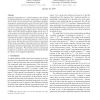Free Online Productivity Tools
i2Speak
i2Symbol
i2OCR
iTex2Img
iWeb2Print
iWeb2Shot
i2Type
iPdf2Split
iPdf2Merge
i2Bopomofo
i2Arabic
i2Style
i2Image
i2PDF
iLatex2Rtf
Sci2ools
129
click to vote
SDM
2007
SIAM
2007
SIAM
Segmentations with Rearrangements
Sequence segmentation is a central problem in the analysis of sequential and time-series data. In this paper we introduce and we study a novel variation to the segmentation problem: in addition to partitioning the sequence we also seek to apply a limited amount of reordering, so that the overall representation error is minimized. Our problem formulation has applications in segmenting data collected from a sensor network where some of the sensors might be slightly out of sync, or in the analysis of newsfeed data where news reports on a few different topics are arriving in an interleaved manner. We formulate the problem of segmentation with rearrangements and we show that it is an NP-hard problem to solve or even approximate. We then proceed to devise effective algorithms for the proposed problem, combining ideas from linear programming, dynamic programming, and outlier-detection algorithms in sequences. We perform extensive experimental evaluation on synthetic and real datasets that de...
Related Content
| Added | 30 Oct 2010 |
| Updated | 30 Oct 2010 |
| Type | Conference |
| Year | 2007 |
| Where | SDM |
| Authors | Aristides Gionis, Evimaria Terzi |
Comments (0)

